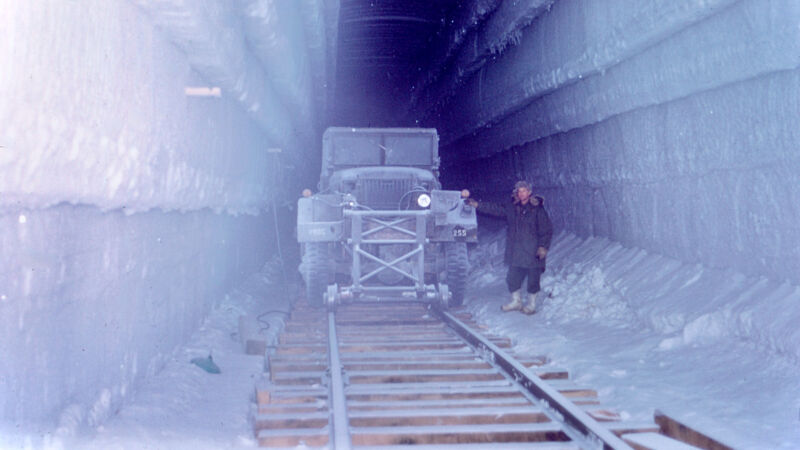
Enlarge / At the US Army’s Camp Century on the Greenland ice sheet, an Army truck equipped with a railroad wheel conversion rides on 1,300 feet of track under the snow.
In recent years, the Arctic has become a magnet for climate change anxiety, with scientists nervously monitoring the Greenland ice sheet for signs of melting and fretting over rampant environmental degradation. It wasn’t always that way.
At the height of the Cold War in the 1950s, as the fear of nuclear Armageddon hung over American and Soviet citizens, idealistic scientists and engineers saw the vast Arctic region as a place of unlimited potential for creating a bold new future. Greenland emerged as the most tantalizing proving ground for their research.
Scientists and engineers working for and with the US military cooked up a rash of audacious cold-region projects—some innovative, many spit-balled, and most quickly abandoned. They were the stuff of science fiction: disposing of nuclear waste by letting it melt through the ice; moving people, supplies, and missiles below the ice using subways, some perhaps atomic powered; testing hovercraft to zip over impassable crevasses; making furniture from a frozen mix of ice and soil; and even building a nuclear-powered city under the ice sheet.
Today, many of their ideas, and the fever dreams that spawned them, survive only in the yellowed pages and covers of magazines like “REAL: the exciting magazine FOR MEN” and dozens of obscure Army technical reports.
Karl and Bernhard Philberth, both physicists and ordained priests, thought Greenland’s ice sheet the perfect repository for nuclear waste. Not all the waste—first they’d reprocess spent reactor fuel so that the long-lived nuclides would be recycled. The remaining, mostly short-lived radionuclides would be fused into glass or ceramic and surrounded by a few inches of lead for transport. They imagined several million radioactive medicine balls about 16 inches in diameter scattered over a small area of the ice sheet (about 300 square miles) far from the coast.
Because the balls were so radioactive, and thus warm, they would melt their way into the ice, each with the energy of a bit less than two dozen 100-watt incandescent light bulbs—a reasonable leap from Karl Philberth’s expertise designing heated ice drills that worked by melting their way through glaciers. The hope was that by the time the ice carrying the balls emerged at the coast thousands or tens of thousands of years later, the radioactivity would have decayed away. One of the physicists later reported that the idea was shown to him, by God, in a vision.
Enlarge / US Army test of the Snowblast in Greenland in the 1950s, a machine designed to smooth snow runways.
Of course, the plan had plenty of unknowns and led to heated discussion at scientific meetings when it was presented—what, for example, would happen if the balls got crushed or caught up in flows of meltwater near the base of the ice sheet. And would the radioactive balls warm the ice so much that the ice flowed faster at the base, speeding the balls’ trip to the coast?
Logistical challenges, scientific doubt, and politics sunk the project. Producing millions of radioactive glass balls wasn’t yet practical, and the Danes, who at the time controlled Greenland, were never keen on allowing nuclear waste disposal on what they saw as their island. Some skeptics even worried about climate change melting the ice. Nonetheless, the Philberths made visits to the ice sheet and published peer-reviewed scientific papers about their waste dream.